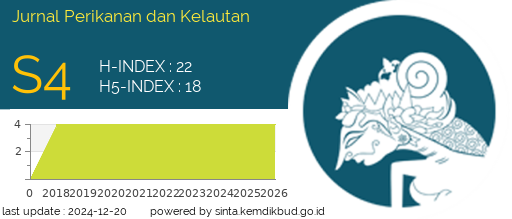Composition and Abundance of Periphyton Types in Artificial Habitat with Different Attractor Media in the Koto Panjang Reservoir Kampar Regency
DOI:
https://doi.org/10.31258/Keywords:
Artificial Habitat, Attractor Media, Periphyton, Plastic BottleAbstract
An artificial habitat comprises a series of structures or attractor media as a habitat for aquatic biota in the waters. This study aims to determine the best attractor media viewed from the abundance of periphyton found in artificial habitats. This research was conducted in July - August 2023 using the experimental method. Periphyton sampling was done four times with an interval of one week and then identified based on the reference identification book. Water quality parameters measured were temperature, brightness, pH, Dissolved Oxygen, nitrate, and phosphate. The data obtained were statistically analyzed using a two-way ANOVA and BNt tests in MS. Excel 2020. The results showed that there were 17 species of periphyton found, consisting of 5 classes, namely Bacillariophyceae (8 species), Zygnematophyceae (4 species), Chlorophyceae (3 species), Cyanophyceae (1 species), and Trebouxiophyceae (1 species). The total abundance of periphyton obtained ranged from 13.448 – 21.406 cells/cm2, and the highest is on plastic bottle attractors ranging from 3.232 – 8.318 cells/cm2. The type of periphyton found mostly was Navicula sp. (6.602 cells/cm2). Based on the periphyton abundance, it can be concluded that the best attractor for periphyton media is the used plastic bottle.
Downloads
References
Akbar, S.N., Dahril, T., Simarmata, A. H. (2018). Jenis dan kelimpahan perifiton pada substrat plastik di Sungai Sail Kota Pekanbaru Provinsi. Jurnal Online Mahasiswa.
Amaliah, A., Siagian, M., Dahril, T. (2020). Jenis dan kelimpahan fitoperifiton pada substrat plastik di Danau Bunter Desa Pangkalan Baru Kecamatan Siak Hulu Kabupaten Kampar Provinsi Riau. Jurnal Online Mahasiswa.
APHA. (2012). Standard method for the examination of water and wastewater. In American Public Health Association/American Water Work Association/Water/Environment Federation Washington (22th Edition). American Public Health Association.
Asra, R., Utami, T.S., Adriadi, A. (2022). Keanekaragaman dan kelimpahan perifiton pada vegetasi tumbuhan di Rawa Bento sebagai bioindikator kualitas air. Jurnal Biospecies, 15(2): 1–10.
Belcher, H., Swale, E. (1978). A beginner's guide to freshwater algae. London: Institute of Terrestrial Ecology.
Biggs, B.J.F., Killroy, C. (2000). Stream periphyton monitoring manual. Niwa. New Zealand.
Budijono, B., Suharman, I., Hendrizal, A. (2021). Dynamics water quality in Koto Panjang Reservoir, Indonesia. IOP Conference Series: Earth and Environmental Science, 934(1): 1–10.
Dionfriski, A., Siregar, S.H., Nurrachmi, I. (2021). Epipelic diatom community structure in the Intertidal Zone Mengkapan Waters, Sungai Apit District, Siak Regency. Journal of Coastal and Ocean Sciences, 2(3): 207–216.
Effendi, H. (2003). Telaah kualitas air: Bagi pengelolaan sumberdaya dan lingkungan perairan. Kasinius. Yogyakarta.
Kurnia, D., Panjaitan, R.S. (2020). Kandungan kimia dari Navicula sp. dan bioaktivitasnya. Indonesia Natural Research Pharmaceutical Journal, 5(1): 65–69.
Nopitasari, E.D., Simarmata, A.H., Sihotang, C. (2017). Types and abundance of periphyton on ceramics substrate placed in the Parit Belanda River, Rumbai Pesisir District, Pekanbaru City, Riau. Jurnal Online Mahasiswa.
Padang, A., Dari, A.L., Latuconsina, H. (2013). Pengaruh intensitas cahaya yang berbeda terhadap pertumbuhan Navicula sp. skala laboratorium. Bimafika, 5(1): 560–565.
PLN. (2002). PLTA Koto Panjang. Perusahan Listrik Negara. Pekanbaru.
Pong-Masak, P.R., Sarira, N.H. (2018). Penentuan jarak tanam optimal antar rumpun bibit pada metode vertikultur rumput laut. Jurnal Perikanan Universitas Gadjah Mada, 20(1): 23–30.
Prescott, G.W. (1974). Algae of the western Great Lakes area. WCM. Brown Company Publisher. Dubuque Lowa.
Rizqina, C., Sulardiono, B., Djunaedi, A. (2017). Hubungan antara kandungan nitrat dan fosfat dengan kelimpahan fitoplankton di Perairan Pulau Pari, Kepulauan Seribu. Journal of Maquares, 6(1): 43–50.
Sheath, R.G., Wehr, J. (2015). Introduction to the freshwater algae (J. D. Wher, R. G. Sheat, & J. P. Kociolek (eds.); Freshwater). Academic Press.
Siagian, M. (2018). Pengaruh budidaya keramba jaring apung terhadap struktur komunitas perifiton pada substrat yang berbeda di sekitar Dam Site Waduk PLTA Koto Panjang Kampar Riau. Jurnal Akuatika Indonesia, 3(1): 26–35.
Sibarani, L.B.G., Dahril, T., Simarmata, A.H. (2020). Jenis dan kelimpahan perifiton dengan substrat bambu di genangan Kelurahan Batu Bersurat Kabupaten Kampar, Riau. Jurnal Sumberdaya dan Lingkungan Akuatik, 1(1): 81 - 92.
Simarmata, A.H., Sihotang, C., Siagian, M. (2017). Produktivitas perairan. Penuntun Pratikum, Fakultas Perikanan dan Kelautan Universitas Riau. Pekanbaru.
Sunarno, S., Harun, H. (2016). Pemasangan habitat buatan (artifisial habitat) di perairan umum Waduk Gajah Mungkur, Wonogiri. Buletin Teknik Litkayasa, 14(2): 103–107.
Supriyanti, S. (2001). Struktur komunitas perifiton pada substrat kaca di lokasi pemeriharaan kerang Hijau (Perna viridis L), Perairan Kamal Muara, Teluk Jakarta. Institut Pertanian Bogor. Bogor.
Tambunan, T., Dahril, T., Simarmata, A.H. (2020). Studi perifiton pada substrat buatan keramik kasar di Waduk Pauh Kecamatan Pangean Kabupaten Kuantan Singingi. Jurnal Sumberdaya dan Lingkungan Akuatik, 1(1): 60 - 69.
Yunfang, H.M.S. (1995). Atlas of freshwater biota in China. China Ocean Press, Beijing.







